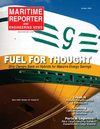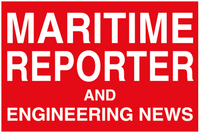
Page 33: of Maritime Reporter Magazine (October 2025)
Read this page in Pdf, Flash or Html5 edition of October 2025 Maritime Reporter Magazine
Command, “these Sailors must be physically strong and able to follow orders under stressful, often dangerous conditions.
In wartime, these combat ‘stevedores’ load and unload vital cargo, often under the threat of enemy ? re.” “Expeditionary logistics allow the Navy to quickly return to maintaining maritime dominance. Our Sailors are trained to operate globally and thrive in littoral environments to rearm,
Equipment Operator 2nd Class Joseph Birl, assigned to
Navy Cargo Handling Battalion ONE (NCHB-1), guides refuel, resupply, repair and revive naval forces to stay in the
Engineering Aide 2nd Class Miya Roman, assigned to Navy ? ght,” said Rear Adm. Brad Andros, commander, NECC.
Cargo Handling Battalion ONE (NCHB-1), transporting ISO
Surface cargo is one of our biggest missions,” said Senior containers with a Kalmar 53K, August 10.
U.S. Navy photo by Mass Communication Specialist 2nd Class Luke Wilson
Chief Boatswain’s Mate Radcliffe Brown, NCHB-1’s training chief. “We equate ourselves to longshoremen or the port ste- and equipment to provide hands-on training and experience. vedores that you would ? nd at any major harbor. But we carry In turn, the battalion provides training to the other NCHBs.
out that function just about anywhere in the world, including “When MSC ships go into maintenance their maintenance done in expeditionary, small-harbor environments.” availability, they’ll pull into the Blount Island facility in Jack-
The battalion works with the Military Sealift Command sonville, Florida. We’ll send a Surface Cargo Company to help (MSC) and Maritime Administration to load or of? oad ships of? oad the cargo. Our teams work with the master of the ship from the Maritime Prepositioning Force (MPF), Maritime Ad- and the port superintendent to move containers and breakbulk ministration Ready Reserve Force (RRF), or other MSC ships cargo. Often times we’re needed to transfer the INLS (Improved and chartered vessels.
Navy Lighterage System) off the ship. We’ll also help train our
For example, NCHB-1 supports the annual Operation Deep reserve battalions during these evolutions,” McPeake said.
Freeze resupply mission in Antarctica. “We’ve been doing that since late 1950s when the mission Pass the Fuel and Ammunition started. Military Sealift Command (MSC) charters a vessel
NCHB-1 can establish fuel service supply points (FSSP) to every year. It’s an ice hardened cargo container ship, and they rearm, refuel, and resupply in support of air operations. “Our ? y our cargo handlers down to McMurdo Sound,” Brown said. FSSPs are mobile, McPeake said. “That’s the point of being “We of? oad all the supplies that are needed to support all the expeditionary. We’re very agile. We can pack everything up
National Science Foundation sites in Antarctica. Typically, it’s pretty quickly and move on to the next location.” somewhere around 1,000 containers that come off the ship. And
The battalion can establish and operate forward fueling then we backload all the trash, science experiments, and every- points in remote and austere locations to provide fuel to air- thing that’s coming out back onto the vessel. It’s a pretty big craft, helicopters, watercraft or vehicles.
mission, obviously, everybody’s always excited to go on that.”
McPeake said the battalion has been busy supporting ord-
Brown said the battalion supports the Marine Corps prep- nance reloads in the Commander U.S. Naval Forces Central osition program, which are ships loaded with the weapons, Command/Commander 5th Fleet operating area in the Middle vehicles and supplies that a Marine Expeditionary Brigade East. This has been especially important to ensure the Navy’s would need to sustain themselves for 30 days. “We are the surface combatants can reload their vertical launch system cargo enablers for of? oading any cargo containers or lighter- (VLS) missile cells after an engagement. age craft, which are the ship-to-shore connectors that are oper- “When you go Winchester—the Navy term for running out of ated by the Amphibious Construction Battalions. Naval Beach ammunition--combatants must reload, and do it quickly,” said
Group is the lead naval support element for that.”
McPeake. “Our combatant ships don’t want to be off station
The battalion of 345 of? cers and Sailors assigned has any longer than they have to, therefore they don’t want to sail steady work that keeps their skills sharp. NCHB-1 has a train- too far to replenish their ordnance. Our Sailors are trained and ing complex with various types of cargo and handling vehicles experienced in loading/of? oading ordnance from our surface www.marinelink.com 33
MR #10 (18-33).indd 33 MR #10 (18-33).indd 33 10/1/2025 7:36:20 PM10/1/2025 7:36:20 PM

 32
32

 34
34
